
Pedestrian bridge to Saint Michel island by Dietmar Feichtinger
Publisher
Petr Šmídek
17.08.2014 11:45
Petr Šmídek
17.08.2014 11:45
Dietmar Feichtinger
Jörg Schlaich
Dietmar Feichtinger Architectes
Schlaich Bergermann und Partner
Mont Saint Michel in French Normandy acts as a magnet for pilgrims from all over the world with the dominant Gothic monastery. The island with the monastery, along with the entire bay, has been listed as a UNESCO World Heritage Site since 1979. The granite island, 80 meters high, is bathed by one of the largest tidal flows in Europe, reaching a height difference of up to 15 meters. The seabed is exposed at low tide up to 10 kilometers away from the shore. Over time, due to sedimentation, the island has become a peninsula, and 130 years ago, a causeway permanently connected the monastery to the mainland, later followed by a narrow-gauge railway. The French government is currently addressing how to slow down the sedimentation of sands around the island. A sum of 164 million euros has been allocated for the construction of marine barriers.
Nine years ago, the idea emerged to build a kilometer-long footbridge that would connect the mainland with the island while also preventing the bay from being obstructed by more causeways and separating tourists from road traffic. The architectural studio of Dietmar Feichtinger from Paris and the engineering office of Jörg Schlaich from Stuttgart were invited to the project. Their joint design is part of the coastal dam preventing further sand from filling the bay. The elevation of the footbridge above the water guarantees access to the island even when the adjacent road is flooded. The footbridge extends from the mainland along with the road, gradually detaching from it and elegantly curling against the incoming currents. The footbridge rests on steel supports placed every twelve meters and anchored to a massive concrete foundation. The walking surface is made of oak planks.
After three years of construction, the pedestrian footbridge was opened to the first pilgrims on July 22, 2014. The official opening of the footbridge is scheduled for November of this year.
More information >
Nine years ago, the idea emerged to build a kilometer-long footbridge that would connect the mainland with the island while also preventing the bay from being obstructed by more causeways and separating tourists from road traffic. The architectural studio of Dietmar Feichtinger from Paris and the engineering office of Jörg Schlaich from Stuttgart were invited to the project. Their joint design is part of the coastal dam preventing further sand from filling the bay. The elevation of the footbridge above the water guarantees access to the island even when the adjacent road is flooded. The footbridge extends from the mainland along with the road, gradually detaching from it and elegantly curling against the incoming currents. The footbridge rests on steel supports placed every twelve meters and anchored to a massive concrete foundation. The walking surface is made of oak planks.
After three years of construction, the pedestrian footbridge was opened to the first pilgrims on July 22, 2014. The official opening of the footbridge is scheduled for November of this year.
More information >
The English translation is powered by AI tool. Switch to Czech to view the original text source.
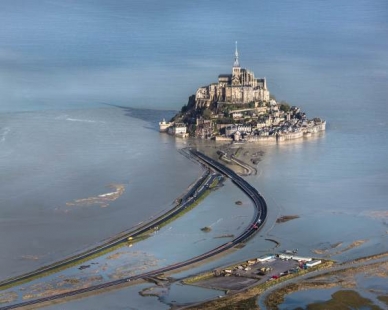
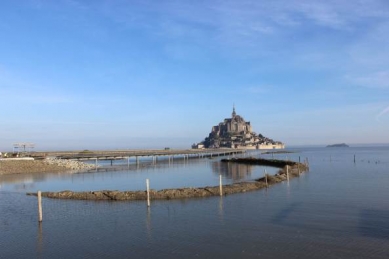
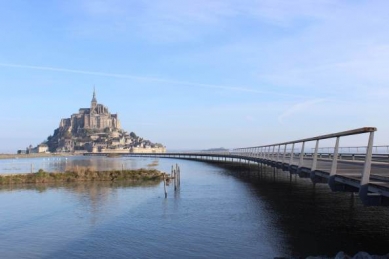
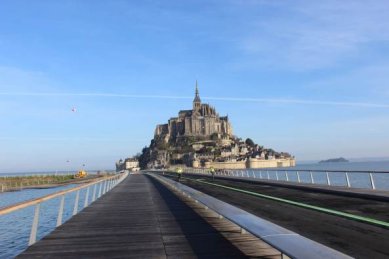
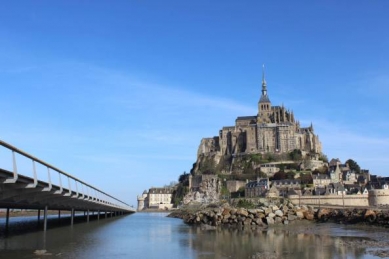
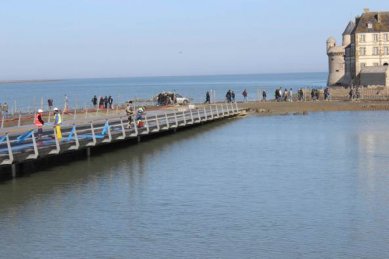
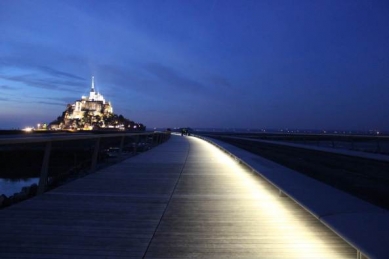
0 comments
add comment
Related articles
1
08.01.2024 | The staff of Mont-Saint-Michel in France is on strike, bothered by the wet conditions and the stairs to the monument
0
11.04.2008 | The famous pilgrimage site Mont-Saint-Michel is preparing to celebrate 1300 years
0
02.12.2007 | Mont-Saint-Michel wants to be a pilgrimage site
0
28.01.2006 | The rescue of the island character of Mont-Saint-Michel officially began












